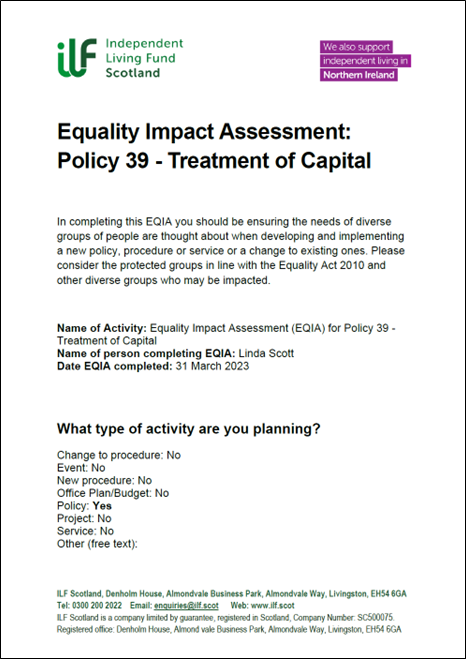
This EQIA, for our 2015 Fund, has been archived but is available for reference purposes.
To see existing policies and EQIAs guiding ILF Scotland, visit our main policies page.
In completing this EQIA you should be ensuring the needs of diverse groups of people are thought about when developing and implementing a new policy, procedure or service or a change to existing ones. Please consider the protected groups in line with the Equality Act 2010 and other diverse groups who may be impacted.
Name of Activity: Equality Impact Assessment (EQIA) for Policy 39 - Treatment of Capital
Name of person completing EQIA: Linda Scott
Date EQIA completed: 31 March 2023
Change to procedure: No
Event: No
New procedure: No
Office Plan/Budget: No
Policy: Yes
Project: No
Service: No
Other (free text):
Policy and wording review.
Amend Policy 39 to reflect that recipients must not have capital exceeding £29,750. This is in line with the thresholds used by Health and Social Care Partnerships (HSCS) in Scotland for residential care charging, and represents an increase to permitted capital of £1250.
All 2015 fund recipients.
The protected characteristics to consider are: Age, Disability, Sex, Race, Religion or Belief, Gender Reassignment, Sexual Orientation, Marriage and Civil Partnership, Pregnancy and Maternity. It will also be helpful to consider these groups more widely in relation to their socio-economic status that includes such factors as educational attainment, occupation, income, wealth and social deprivation.
Please mark as Yes or No. If yes use the Comments column to describe what the potential impact is. What are your sources of evidence?
(Try to think about both positive and negative impacts. There are lots of sources of data to help answer this question. Diversity Networks, the Diversity Report or Diversity & Inclusion team may offer some useful information. Previously completed EQIAs may also offer answers to questions you may have).
Age: No
Comments:
Disability: No
Comments:
Gender Reassignment: No
Comments:
Marriage and Civil Partnership: No
Comments:
Pregnancy and Maternity: No
Comments:
Race: No
Comments:
Religion or belief: No
Comments:
Sex: No
Comments:
Sexual orientation: No
Comments:
(For example, carer status, single parent, economic exclusion. It is important not to limit your thinking just to the protected characteristics listed above. This question is broadening the EQIA out to be more inclusive. The impact might be a negative one (e.g. making that decision could decrease the opportunity for some people to participate) or it could be a positive one (e.g. by making that decision, more people are able to take part in the activity).)
Carers: No
Comments:
If there are any gaps in information that make it difficult or impossible to form an opinion on how your policy, service or change might affect different groups of people, please take the time to gather information to help you make an informed answer (for example, review statistics, survey results, complaints analysis, consultation documents, customer feedback, existing briefings submissions or business reports, comparative policies from external sources and other Government Departments etc).
Desk research, consultation with ILFS Assessors, Specialist Caseworkers, Recipients, Award Managers, Scottish Advisory Group, NI Stakeholder Group.
Age: No
Disability: No
Gender Reassignment: No
Marriage and Civil Partnership: No
Pregnancy and Maternity: No
Race: No
Religion or belief: No
Sex: No
Sexual orientation: No
No adverse impact determined
Age: No
Disability: Yes
Comments: Recipients are already a disadvantaged group with a high association with poverty, debt and higher costs of living. An increase to the permitted amount of capital they can have in order to remain eligible for ILF means they could be better off financially, and less likely to become ineligible.
Sources: Disability Price Tag | Disability charity Scope UK and Disabled people's costs of living | JRF
Gender Reassignment: No
Marriage and Civil Partnership: No
Pregnancy and Maternity: No
Race: No
Religion or belief: No
Sex: No
Sexual orientation: No
Once approved by our Sponsor Team / Scottish Government, we will provide an update for Assessors and Caseworkers to ensure they are aware of the increase.
We will continue to discuss with and inform Recipients / Award Managers of this policy via our website, and contact with our Assessors and Specialist Caseworkers, Scottish Advisory Group and NI Stakeholder Group.
Ongoing monitoring and review of policy impact on Recipients and their Award Manager via feedback from Assessors and Specialist Caseworkers, Management Team, and Senior Management Team. Policy will be signed off by Linda Scott, Director of Policy, Improvement and Engagement.